purīyaū
To come with noise as wind through a hole, as a sound from a trumpet.
To make any buzzing noise as an instrument with a faulty tongue.
To breathe making a noise as when one has a cold, to pass air through the nose with noise.
(from Yamana English Dictionary – a Dictionary of the Speech of Tierra del Fuego, by Reverend Thomas Bridges, 1865)
Voice and terrain
Early travellers encountering Tierra del Fuego and its inhabitants had comments about the particular sound of their language(s). Written accounts, dictionaries and recordings reveal fascinating insights in to cultures that are deeply entangled with their natural habitat.
This project grew out of a commitment to those entanglements and attempts to trace exchanges between cultural features and material properties of the location. In particular language-landscape links that go beyond mere vocabulary encapsulations of topography, seeking instead elemental imprints of terrain and climate on the sonority of spoken words.
This hunch was informed by ongoing preoccupations with listening and hearing in general but also importantly shaped by our own in-situ experiences of vocalizations in the specific landscape conditions often characterized by exceptionally dense vegetation and erratic, high velocity, winds.
One hypothesis was the importance of consonants and syllable rhythmicity for speech comprehensions in outdoor windy conditions. In other words the particular importance of articulated breaks punctuating the audible organization of words primarily spoken outdoors.
The particular sonority of Fuegian languages —often described by foreigners in degrading terms— seems to have fallen awkwardly on ears of visitors accustomed to speech within confining walls. That same heightened attention to features of spoken language may also indicate the primacy of specific modes of sounding in Fuegian languages. In other words local idiosyncratic quirks of sounding may be important structural feature in developments of the languages, especially in pre-literate, environmentally entangled surround. This hunch is strengthened by recent phonology research, drawing links between linguistic and environmental traits.
A standard assumption in linguistics is that sound systems are immune to ecological effects. This presumption has been called into question by several recent studies providing evidence for a correlation between aspects of phonology (such as sonority) and climatic and geographic factors (such as temperature, plant cover, or terrain), as well as behaviors associated with such factors.[1]
Climate, vocal folds, and tonal languages – Connecting the physiological and geographic dots
Caleb Everett, Damián E. Blasi and Seán G. Roberts
[…] In some cases, as in recent migration by people to a new and different geographic and climatic area, sonority scores might better reflect historical circumstances than current conditions, and this possibility should be looked into as further inquiry is undertaken. For the climatic variable, other factors besides temperature, for example, humidity, rainfall, cloud cover,and the vegetative environment, could all affect habitat acoustics and ideally would be taken into account in considering outdoor vocal communication. In addition, temperature alone may not prove the best way to evaluate the degree to which peoples engage in outdoor activities. For instance, the Ona occupy a rigorous,demanding habitat at the southern tip of South America and are rated as having 12 cold months per year. But all their activities are performed “outdoors” because the Ona construct only rude vertical windbreaks and even sleep in the open (Cooper, 1946; McEwan, Borrero, & Prieto, 1997, Handbook of South American Indians; Ona). An experimental research effort might provide valuable insight into our questions, especially those surrounding distance and speech communicability…[2]
Sonority and Climate in a World Sample of Languages: Findings and Prospects
John G. Fought, Robert L. Munroe, Carmen R. Fought and Erin M. Good
Wax Cylinder recordings
The Austrian missionary and ethnologist Martin Gusinde[3] undertook four research trips to Tierra del Fuego between the end of 1918 and 1924 with the aim of describing and documenting the three ethnic groups populating the region. At the time, the Selk’nam, Yámana and Kawésqar indigenous populations were dangerously nearing extinction, following displacement and disease brought on by waves of colonizing migrants. (see for example: Tierra del Fuego – The Genocide of the Indian Population[4]) Gusinde’s effort resulted the four-volume work “Die Feuerlandindianer” that is still considered a crucial document with important insights into local traditions and cultures.
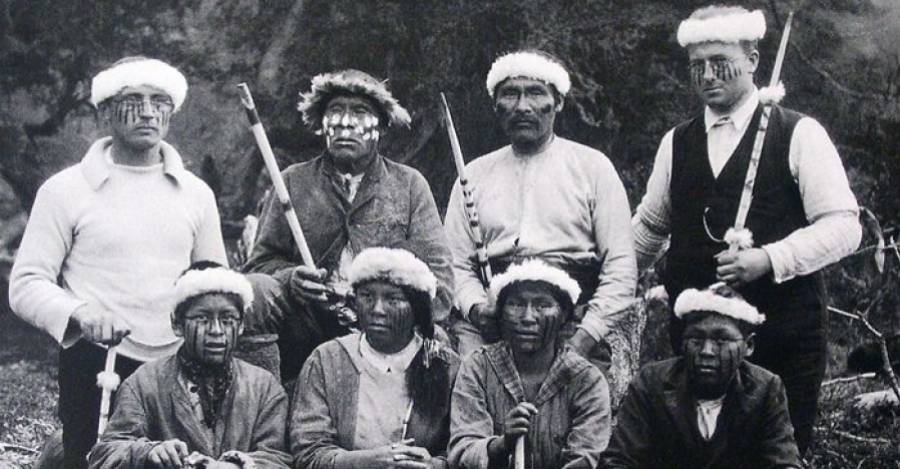
On the last extensive journey in 1923/24, Gusinde also conducted sound recordings of the Fuegians on behalf of the Berlin Phonogramm-Archiv and the musicologist Erich von Hornbostel. The recordings were completed with an Edison phonograph on 30 wax cylinders. The process was technically primitive and prone to interference, and under the circumstances it was a complicated undertaking. The recordings were purely mechanical, no electronic amplification was involved in the registration process and the apparatus was heavy and bulky to transport. Due to the rather large sound-pressure required in the recordings the sounding subjects needed to be close by the horn opening – most of the ambient sounds of the surrounds were dampened in the process. The wax cylinders were fragile and sensitive to changes in temperature, the large recording horn also collected and funneled wind pressure towards the diaphragm, making recordings susceptible to noise.
Charles Wellington Furlong, who had already made recordings with the phonograph in Tierra del Fuego between 1907 and 1908, wrote: “Securing the phonograph records proved most interesting, but it was not easy to induce the aborigines to talk or sing into this uncanny thing. A thing which sang back to them their own voice, shouts, embarrassed laughter, and even the sound of their breathing, was to be approached with discretion. Some of the singers would break down in the middle with a hilarious fit of laughter or suddenly run away altogether from the machine.” [5]
Furlong’s manuscripts also provide a startling account where a group of Onas, upon hearing the shaman Tininisk emerging from the phonograph and thinking the shaman was under the interloper’s control, considered killing Furlong to free Tininisk from their clasp.

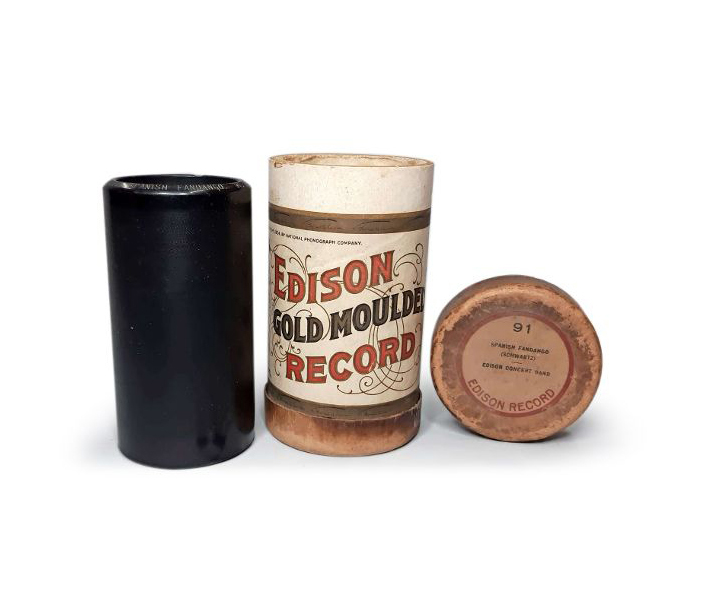

The Berlin Phonogramm-Archiv still houses the complete collection of Gusinde’s wax cylinders as well as additional recordings by his colleague Wilhelm Koppers and Charles Wellington Furlong (76 cylinders in total).
The collection passed over to Russian hands after the Second World War (transported to Leningrad) and brought back to East Berlin in 1960. The recordings from Tierra del Fuego were considered lost until the final return of the wax cylinders after the fall of the Berlin Wall to the Museum für Völkerkunde in Dahlem for their renewed cataloguing.
The Gusinde-Feuerland-Collection was digitised in 1998 using a device developed by Dipl.-Ing. Franz Lechleitner (formerly of the Vienna Phonogrammarchiv). With this device, a pick-up system on a tangential tone arm with optoelectronic needle tracking scans the groove on the cylinder surface. No sound-enhancing measures were taken during the digitization. Some of the recordings were published in 2017 together with the Koppers and Furlong collections.[6]
Fuegian Languages
Erich von Hombostel’s analysis of the Gusinde, Koppers and Furlong cylinder recordings was published 1948 under the title “Music of the Fuegians”[7] as a purely ethno-musicological document. But the recordings also provide rich information regarding the languages of the Selk’nam, Yámana and Kawésqar.
The strange impression that the Selk’nam language, rich in gutturals and explosive sounds, makes on the ears of a foreigner, was already expressed in words by the oldest seafarers; here, as an example, only a quotation from Banks (p. 59), who comments as follows: „…their language is guttural, especially in particular words, which they seem to express much as an Englishman when he hawkes to clear his throat. But they have many words which sound soft enough”10. […] The phonetician’s ear could experience a true delight when some of the women in the camp had to call out certain “kindnesses” to each other: the whole power of their voice now seemed to shift into the explosive sounds that from a certain distance sounded like a light crack of a whip.[8]
Though Gusinde’s commentary — when compared to other colonial accounts — is nuanced and descriptive, it also contain biases that need more careful unpacking and possibly reading against the grain, particularly with regards to linguistic observations and voice documentation. The seemingly innocent activity of sonic documentation inevitably participates in programmatic schematizations of cultures, set into broader power regimes, that more often than not, tend to express colonial superiority and might. The embodiment of these larger, often mute, relationships and contexts participating in the recordings is aptly described by García and Haas:
When the phonograph was put into operation, the relationship between Gusinde and the young Selk’nam was already predetermined by various framework conditions: the possibilities of the recording device (for example, the duration of the recording was limited to approx. 3 minutes), the wishes of the Berlin musicologists (the fact that Gusinde was recording for others whom he considered experts certainly influenced his decisions about the subject matter and nature of the recording), the scientific-ideological perspective of the collector, his European-influenced aesthetics that determined his values about what was captured on the cylinders, and the immediately preceding experience in which the knowledge and solidarity of the two young Fuegians had saved Gusinde’s life. This means that the knowledge Gusinde constructed through recording the songs was determined or influenced by technical, scientific, ideological, aesthetic and emotional factors.[9]
The linguist Luis Miguel Rojas-Berscia wrote in 2014 about the historic perception of the Phonology of Selk’nam:
The sounds of unfamiliar languages like Selk’nam, part of very different phonological inventories, have been the subject of great debate among linguists. Tonelli (1926)[10] gathered some impressions of acknowledged scholars by that time that had contact with the Onas:
The language of the Ona is so difficult that, since heard from the first time, we come up with the idea that the one speaking produces the strangest sounds in order to capture the attention or the astonishment of the listener (Thomas Bridges).
Their language, to be honest, does not merit the title of articulated, because with rough, clucking and guttural sounds, it is similar to the rumour produced by whom, with a cold, would violently scrape off (Domenico Lovisato)[11]
Possibly the most contentious commentary comes from one of the twentieth century’s most infamous observers – Charles Darwin:
“The language of these people, according to our notions, scarcely deserves to be called articulate. Captain Cook has compared it to a man clearing his throat, but certainly no European ever cleared his throat with so many horse, guttural and clicking sounds.”[12]

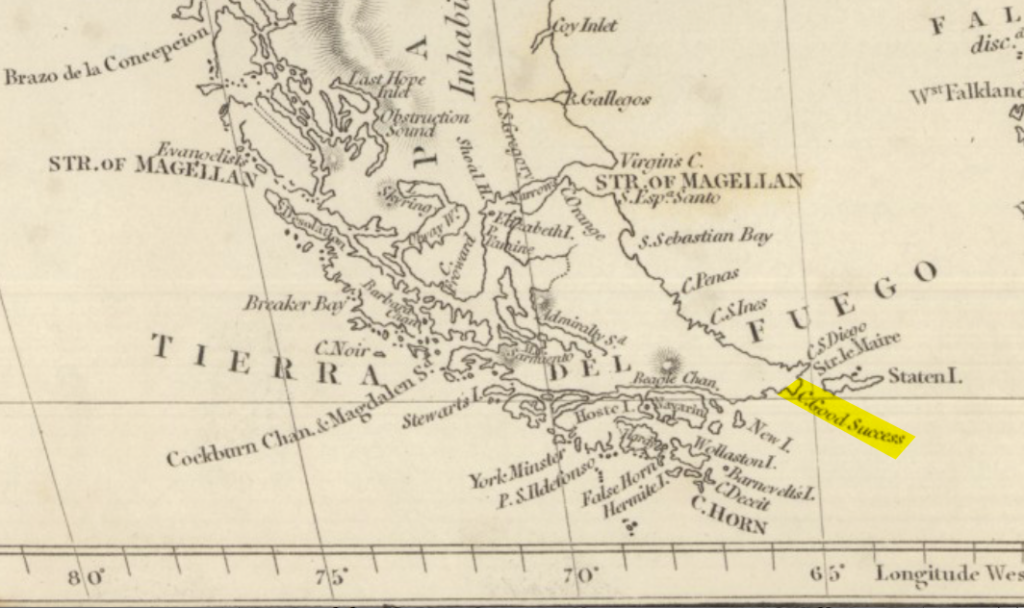
Rojas-Berscia explains this audible specificity of the glottalized stops in the following:
The stops k, č, t, p can be violent; i.e. that the medio-guttural, palatal, dental or bilabial closure is accompanied by the closure of the larynx. The comprised air between the two articulations is strongly compressed in the same way as the air inside the lungs: indeed, reproducing the sounds, the contraction of the abdominal muscles can be averted. First there is a sudden and explosive opening of the superior closure, which produces a violent rumor, brief, unvoiced, as if it was accompanied by the sounds
After a short time, the opening of the larynx occurs; therefore, these consonants remain separated from the rest of the word by a short variable time, ordinarily the one necessary for the pronunciation of the vowel.)[11]
Fuegian languages and dialects are well documented and linguistically classified. For the most part they are no longer considered actively spoken languages. However there are current efforts to re-learn, mediate, preserve and even revive these language.[13] The historical recordings provide important clues for this, although a direct understanding of the language is difficult to establish. Already in 1908 the ethnologist Robert Lehmann-Nitsche points towards some of the difficulties:
In any case, one must know the language in question precisely in order to be able to put it down on paper according to the phonograms; even then, this is sometimes still quite difficult, and gaps will always remain where, with the best will in the world, nothing precise can be heard. In the case of an unknown idiom, however, only the speaker himself or someone who speaks the same language, possibly as a mother tongue, can understand the phonograms correctly and dictate them into the pen, for both parts an extremely laborious and nevertheless sometimes unsuccessful task.[14]
Among Gusinde’s recordings, there was a single recording containing only speech utterances (and not songs) with Selk’nam vocabulary spoken by Antonio Toin, recorded on 27.07.1923 in Remolino with the label Cylinder #4. The recording is a simple sequence of spoken words, each repeated twice. The archived recording had no specification beyond the name of the subject, the location and date of the recording. After careful listening of our team members Hema’ny Molina and Fernanda Olivares (representatives of the Selk’nam community) more than half the words were eventually deciphered. Spoken words from that cylinder recording served as the basis of the voice transmission experiments conducted in the recent journey to Tierra del Feugo.
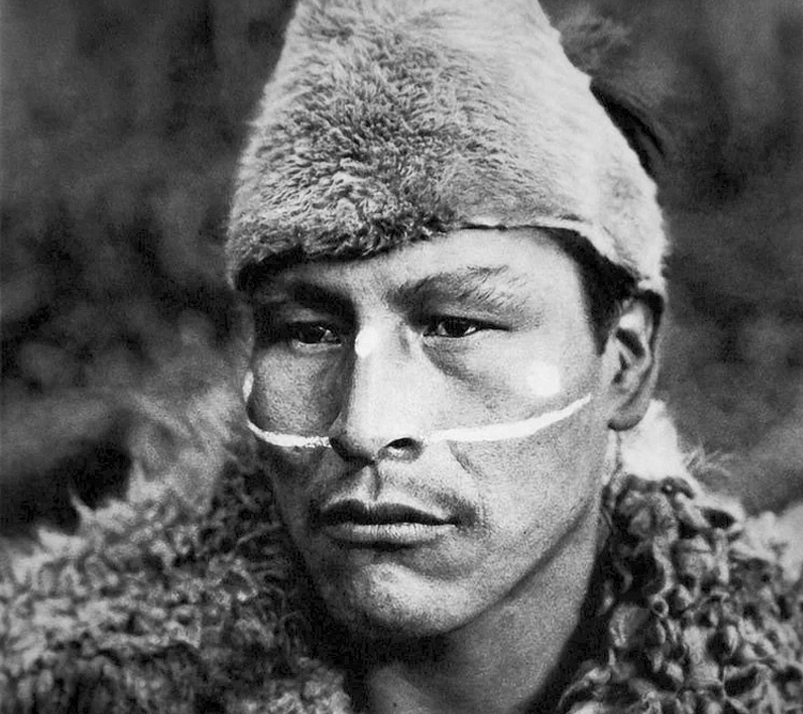
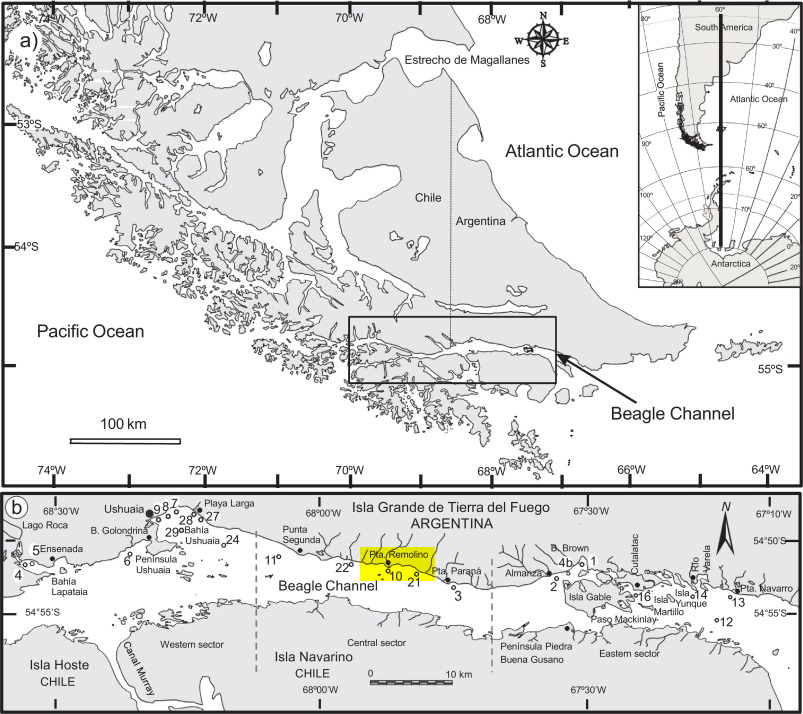
Environmental-Linguistic Approach
We were particularly interested in the possible influences of environment and climate on language development in the specific geographic region. The passage between Yendegaia and Admiralty Sound described as a possible historical “intercultural contact zone” and “pass of communication” seemed like an appropriate locale to test the interactions of voice and terreign. The first crossing attempt had very clearly illustrated the necessity of accentuated speech communication when moving in the very complex terrain where paths are non-existent and dense vegetation impedes visibility.
Following the language-landscape hunch, we developed an experimental approach with which to conduct a systematic comparison of voice propagation and speech intelligibility in the field. For the field tests, the above-mentioned wax cylinder containing utterances of Antonio Toin — the Selkn’am recorded by Gusinde — was de-noised, edited and sequenced in combination with acoustic test signals (white noise and an audible spectrum sine wave-sweep). Using a mobile playback system[15], the signal was reproduced in various environments and recorded in each case at a distance of 50m from the sound source with identical registration settings.[16] Each sequence was capped with an analogue test tone of 410 Hz played by Kerstin Ergenzinger on a 3D-printed mouth-piece.
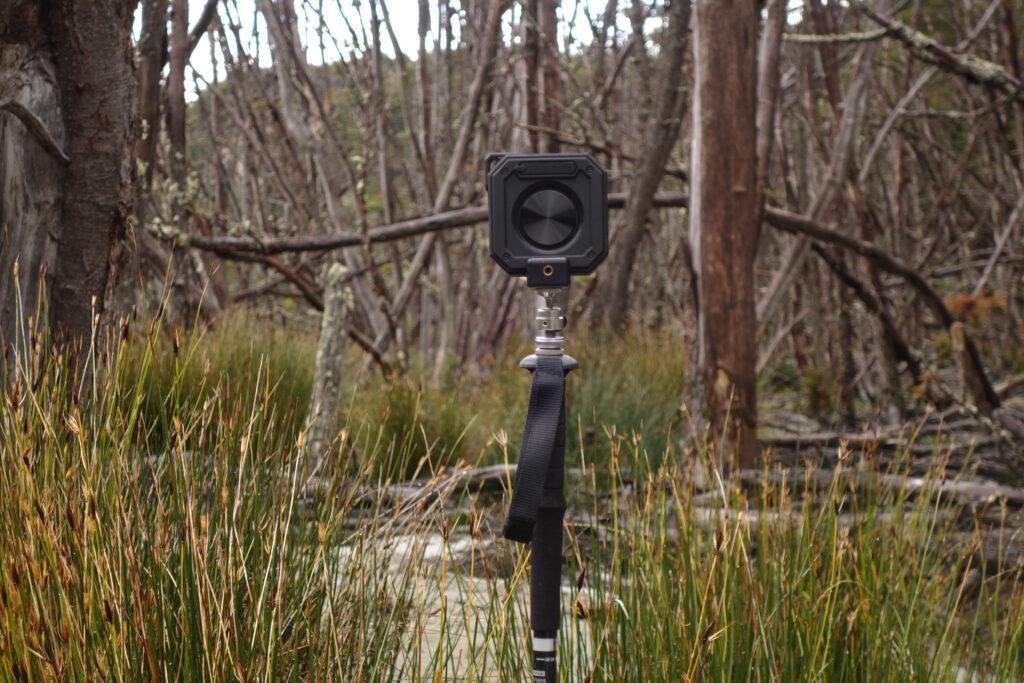
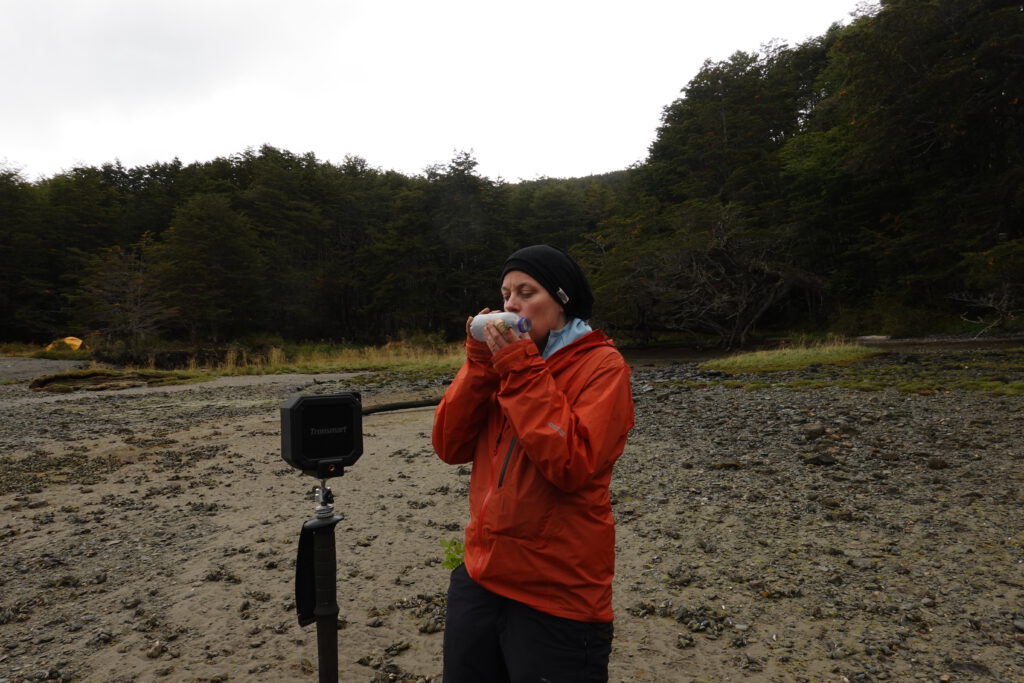
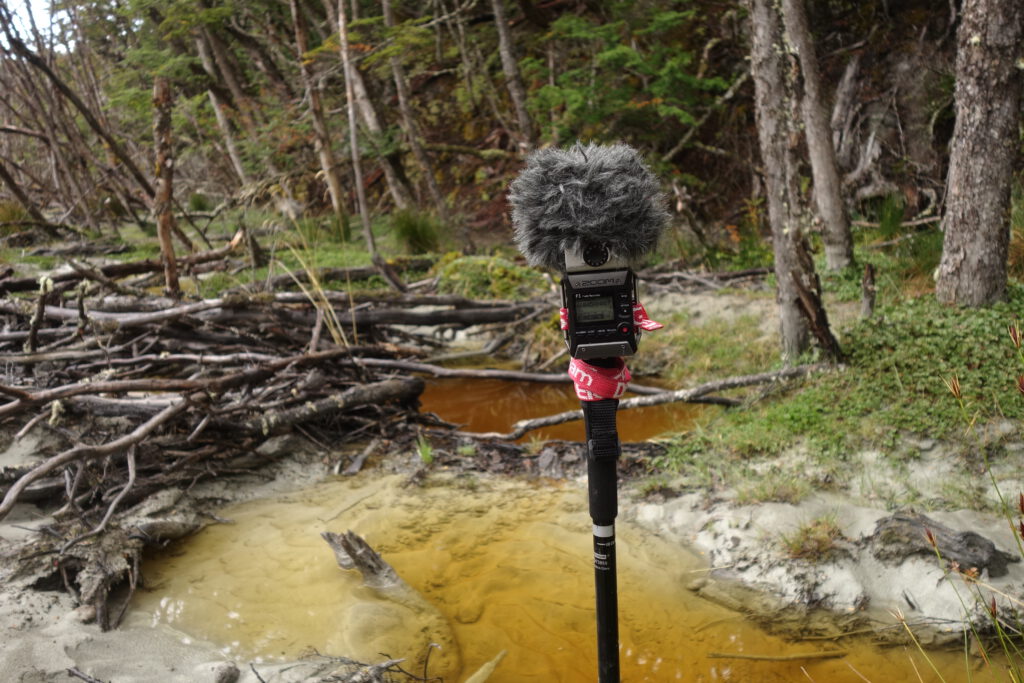
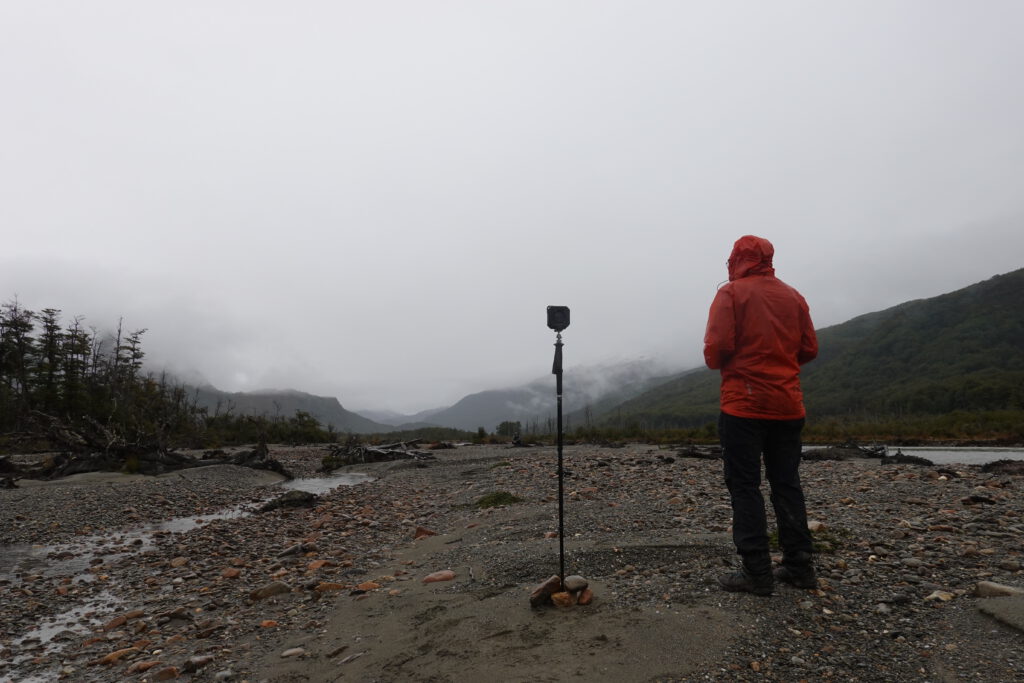
Recording situations along the pass varied between open grass and swamp land, dense forest, differing vegetation and foliage conditions, hilly terrain, bedrock, debris surfaces and river courses as well as wind, rain and flow noise of varying intensity and the resulting absorption, reflection, resonance, amplification and masking effects – nuances of environmental ambience that could not have been captured in in cylinder recordings from the previous era. The locations for the recording set-ups were often at sites identified by Alfredo Prieto and Robert Carracedo as temporary resting places or shelters along the crossing pass through indications of cultural marks (crushed bones, worked no-local lithic materials, shell midden, burn- and bark marks). Other locations were chosen for the specificity of terrain conditions encountered in passing.
One of our hypotheses of speech intelligibility in windy conditions was the special importance of consonants within the phonetic organisation of voice sounds.
The principal acoustic features of speech can be understood by following the manner in which they are produced through the human vocal apparatus. A simple model of this physical process is described by the source–filter theory of speech production. Humans produce speech by first converting air from the lungs into sound waves. This sound source is subsequently modified, or filtered, into distinctive speech sounds using the articulators in the vocal tract.[17]
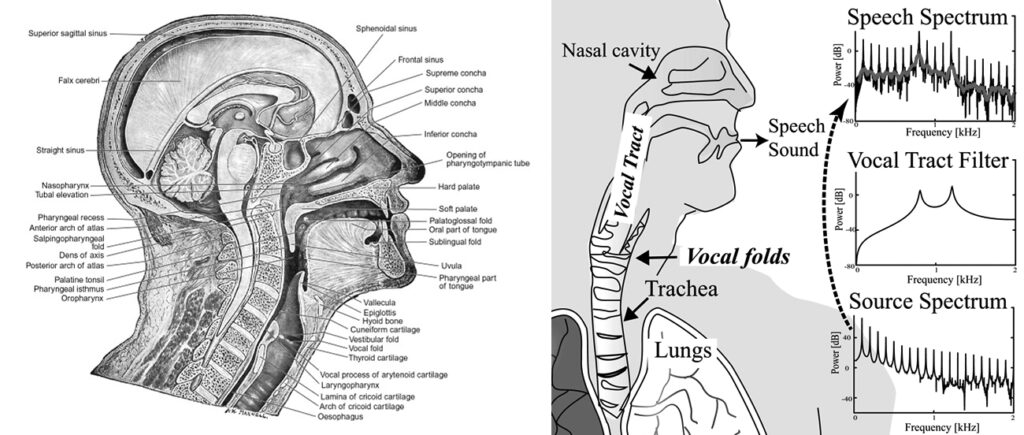
The consonants are produced by air blockages and sounds created by the flow of air through the throat and mouth, especially through the tongue and lips. The consonants and especially glottalized stops (k, č, t, p etc.) described by Berscia are predominantly found in the frequency range above 500 Hz. More precisely, in the range from 2 kHz to 4 kHz.
Listening to the recordings and looking at the corresponding frequency spectrograms – these vocal sounds penetrate even densely saturated acoustic environments. The sharply accentuated Selk’nam speech caused by the glottalized stops could be conditioned by a necessity of communication, primarily outdoors under difficult climatic and topographical circumstances.
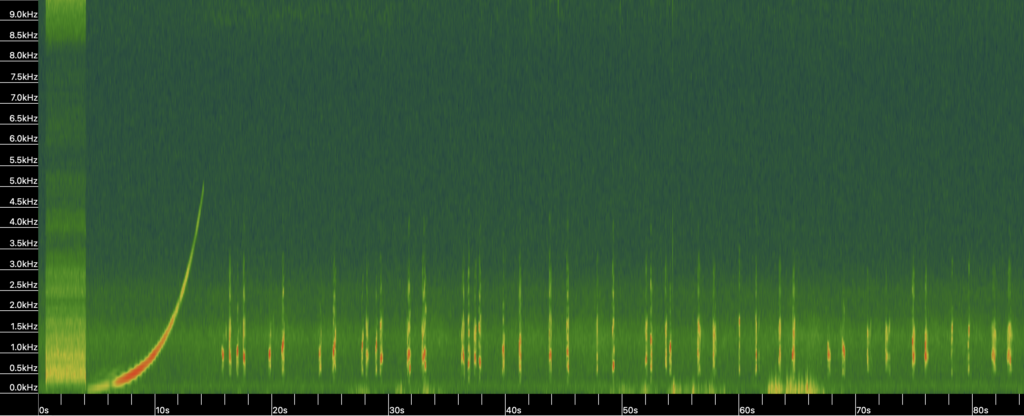
A further evaluation of the recordings and the comparison suggest two preliminary characteristics that seem to cut through various kinds of diverse terrain and could be factors for speech intelligibility over larger distances.
(excerpts from recordings R01/R05/R06/RR03/R09 are edited together as a sequence, +26dB, HiPass30Hz)
(excerpts from recordings R01/R05/R06/RR03/R09 are edited together as a sequence, +26dB, HiPass30Hz)
However, we are still very much in the early stages of evaluating the data. The recordings must be analyzed in more detail (technically and aurally) and systematically compared between various locations, and further in-situ experiments must be realized. Although the only existing recording of speech was a useful starting point, we also recognize that the Gusinde recordings of Antonio Toin are problematic as a neutral reference, since the speech is likely orchestrated for, and coloured by, the analogue cylinder recording process. Heman’ny Molina recommended to re-recorded the vocabulary with adjusted levels to ensure a more natural pronunciation and cadence. Further investigations into the directionality of voice propagation need to be closely calibrated with the playback system to achieve a corresponding spatial projection of speech over distances.
(project carried out by Carsten Stabenow and Raviv Ganchrow)
[1] Everett, Cale, Blasi, Damián E. and Roberts, Seán G., Climate, vocal folds, and tonal languages – Connecting the physiological and geographic dots, https://www.pnas.org/doi/full/10.1073/pnas.1417413112
[2] Fought,John G., Munroe, Robert L.m Fought, Carmen R. and Good, Erin M., Sonority and Climate in a World Sample of Languages: Findings and Prospects, https://www.researchgate.net/publication/275810414_Sonority_and_Climate_in_a_World_Sample_of_Languages_Findings_and_Prospects
[3] https://en.wikipedia.org/wiki/Martin_Gusinde
[4] https://en.wikipedia.org/wiki/Tierra_del_Fuego#European_colonization_and_extinction_of_Native_Americans_(1860–1910)
[5] Furlong, Charles Wellington, Cruising with the Yahgans, in Outing 58, no. 1 (1911)
[6] Walzenaufnahmen aus Feuerland. Die Tonaufnahmen der Selk’nam, Yámana und Kawésqar im Berliner Phonogramm-Archiv, Historische Klangdokumente 12/13, Berlin, 2017
[7] Hornbostel, Erich M von, The Music of The Fuegians, Ethos, 1948, https://www.tandfonline.com/doi/abs/10.1080/00141844.1948.9980678?journalCode=retn20
[8] Gusinde, Martin, Das Lautsystem der feurländischen Sprachen, Anthropos, 1926 (Trans. CS)
10 Joseph Banks: Journal of the Right Hon. J. Banks during captam Cook’s iirst voyage…, ed. by Sir Joseph D. Hooker. London 1896.
[9] García, Miguel A., Haas, Richard, Walzenaufnahmen aus Feuerland. Die Tonaufnahmen der Selk’nam, Yámana und Kawésqar im Berliner Phonogramm-Archiv, Historische Klangdokumente 12/13, Berlin, 2017
[10] Tonelli, Antonio (1926) Grammatica e glossario della lingua degli Ona Šelk’nám della Terra del Fuoco Turin: Società Editrice Internazionale. VIEGAS BARROS, J.P. (1992) “La familia lingüística tehuelche”. Revista Patagónica. 13, 54. Buenos Aires, 39-46.
[11] Rojas-Berscia, Luis Miguel, A Heritage Reference Grammar of Selk’nam, 2014, http://etnolinguistica.wdfiles.com/local–files/tese%3Arojas-berscia-2014/rojas_berscia_2014_selknam.pdf
[12] Darwin, Charles, Voyage of the Beagle, 1839, pp. 228-229
[13] Zárraga, Christina, Vogel, Oliver, Meroz, Yoram, Yapimáta háu´usi kuta, Conversar en el Idioma de mi Tierra, 2020, https://peib.mineduc.cl/wp-content/uploads/2022/03/yapimata_compressed.pdf
[14] Lehmann-Nitsche, Robert – Patagonische Gesänge und Musikbogen, Anthropos, 1908
[15] Playback; Active Monitor, company: Tronsmart, Model: Element Groove (Force Mini) 10W, 20Hz-20KHz, playback level: max
[16] Recording: Zoom F3 + Zoom XYH-6 capsule (pair of angled unidirectional/cardioid microphones, switched to 120° angle), rec-level: 8
[17] Tokuda, Isao, The Source–Filter Theory of Speech, https://doi.org/10.1093/acrefore/9780199384655.013.894
